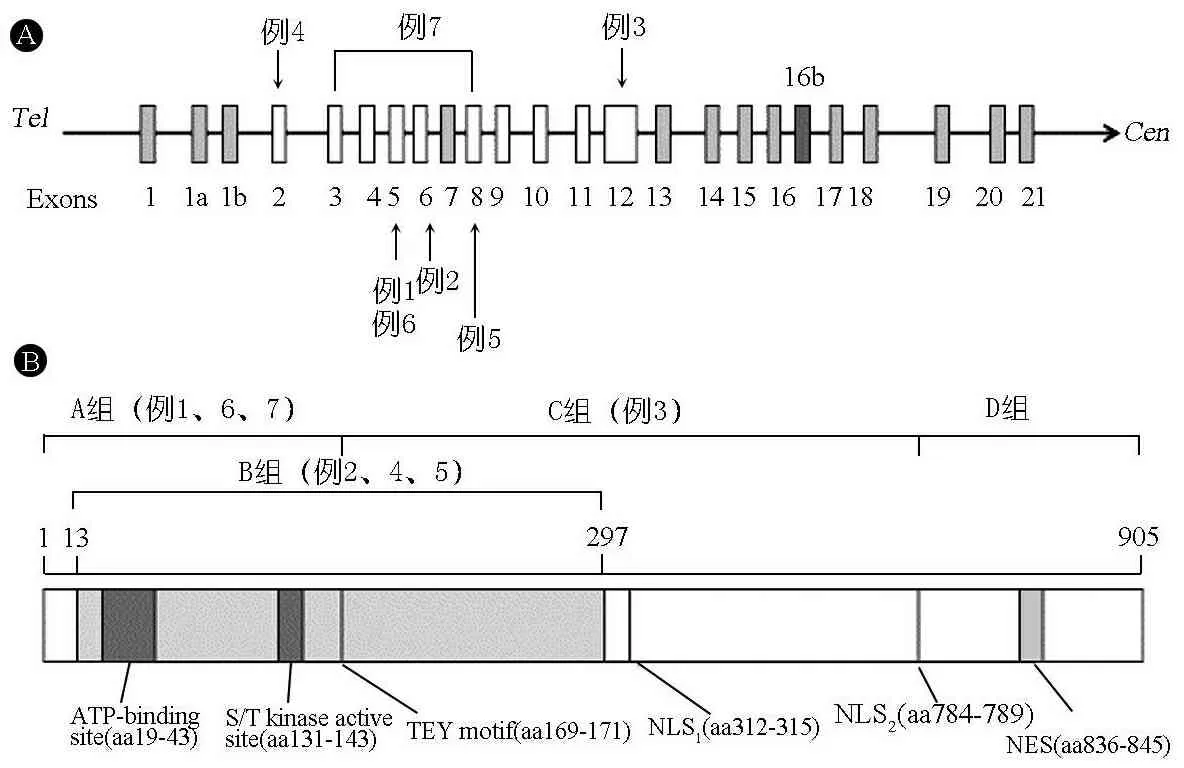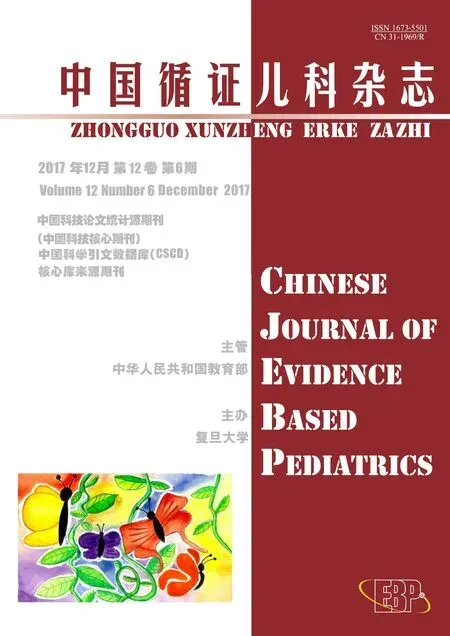CDKL5综合征7例病例报告
熊 娟 彭 镜 段浩林 陈施梦 尹 飞

1 病例资料


表1 7例CDKL5患儿临床资料

7例患儿起病年龄为22 d至8月龄,中位年龄2月龄。就诊年龄为1月龄至8月龄,中位年龄2月龄。病初发作形式多单一,例3~6表现为部分性发作、例1~4和7为强直发作,随病情进展7例发作形式、发作频次均逐渐增多,均有痉挛发作表现,例1、3和7肌阵挛发作也较为常见,例3在4岁7月转化为Lennox-Gastaut综合征。例7在出现抽搐前即有精神运动发育落后,表现为3月龄竖头不稳,6月龄不能独坐,余6例患儿在起病后出现精神运动发育迟滞。7例均有幼稚面容,例1、2、6和7有异常面容的表现;例4和7有明显头围增长进行减速;例2、5和7有眼球异常运动(斜视、眼球震颤);部分患儿有吐舌头、不自主运动异常行为,伴有拍手等手刻板动作;例1和2四肢肌力低、例1~4和7肌张力低。



图1本文7例患儿CDKL5基因模式图及突变位点
注 A:CDKL5模式图及本文7例患儿基因突变位点[例1:c.278dupA (p.E93fs);例2:c.401G>C (p.G134P);例3:c.1110del C (p.E370fs);例4:c.58G>C (p.G20R);例5:c.464G>A (p.G155D);例6:c.160-163del (p.K54fs);例7:3~8号外显子杂合缺失];B:CDKL5突变位点分组标准及本文7例患儿分组(a组:aa172前的截短突变致编码的蛋白无功能/CDKL5整体缺失;b组:激酶区域内的错义/框内突变;c组:aa172~aa781之间的截短突变;d组:aa781(不包含aa781)的截短突变

2 讨论



起调节表达作用,可以调节其激酶活性和核酸定位[17,18]。Fehr研究团队在既往CDKL5研究成果的基础上,结合国际CDKL5综合征数据库的临床数据,在2015年首次提出将CDKL5突变分为4种类型(见图1):①第172个氨基酸前出现截短突变导致催化区域功能丧失或整个基因缺失;②催化区域内的错义突变或框内突变(如缺失导致一部分激酶区域功能丧失但其后的蛋白编码完整);③第172~781个氨基酸之间的截短突变,包括移码突变、无义突变等突变类型导致C末端区域丢失但仍有激酶活性;④第781个氨基酸以后的截短突变,保留了激酶活性及大部分C端区域。在此分组基础上,近年来研究表明,D组的CDKL5综合征患儿智力发育较其他组别好,在大运动能区上更可能独站或独走,言语能区上更可能有语言表达发育[19,20]。本文报告的7个突变位点可应用相同分组原则,例1、6和7的突变属A组,病例2、4和5的突变属B组,病例3的突变属C组。结合Fehr等的研究结果,这也解释了本文患儿智力发育均较差的原因。

[1]Lin C, Franco B, Rosner MR. CDKL5/Stk9 kinase inactivation is associated with neuronal developmental disorders. Hum Mol Genet, 2005, 14(24): 3775-3786
[2] Fehr S, Wilson M, Downs J, et al. The CDKL5 disorder is an independent clinical entity associated with early-onset encephalopathy. Eur J Hum Genet, 2013;21: 266-273
[3] Kalscheuer VM, Tao J, Donnelly A, et al. Disruption of the serine/threonine kinase 9 gene causes severe X- linked infantile spasms and mental retardation. Am J Hum Genet, 2003, 72(6): 1401-1411
[4] ZhaoY, Zhang X, Bao X, et al. Clinical features and gene mutational spectrum of CDKL5-related diseases in a cohort of Chinese patients. BMC Medical Genetics, 2014, 15: 24
[5]Allen AS, Berkovic SF, Cossette P, et al. De novo mutations in the classic epileptic encephalopathies. Nature, 2013, 501(7466): 217-221
[6]Tan WH, Bird LM, Thibert RL, et al. If not angelman, what is it? A Review of angelman-like syndromes. Am J Med Genet A, 2014, 164A(4): 975-992
[7] Codina-Solà M, Rodríguez-Santiago B, Homs A, et al. Integrated analysis of whole-exome sequencing and transcriptome profiling in males with autism spectrum disorders. Mol Autism, 2015, 6: 21
[8] Fehr S, Wong K, Chin R, et al. Seizure variables and their relationship to genotype and functional abilities in the CDKL5 disorder. Neurology, 2016, 87(21): 2206-2213
[9]Bahi-Buisson N, Bienvenu T. CDKL5-related disorders: from clinical description to molecular genetics. Mol Syndromol, 2012, 2(3-5):137-152
[10] Mei D, Darra F, Barba C, et al. Optimizing the molecular diagnosis of CDKL5 gene-related epileptic encephalopathy in boys. Epilepsia, 2014, 55(11): 1748-1753
[11]Mirzaa GM, Paciorkowsk AR, Marsh ED, et al. CDKL5 and ARX mutations in males with early-onset epilepsy. Pediatr Neurol, 2013, 48(5): 367-377
[12]Liang JS, Shimojima K, Takayama R, et al. CDKL5 alterations lead to early epileptic encephalopathy in both genders. Epilepsia, 2011, 52(10): 1835-1842
[13]Evans JC, Archer HL, Colley JP, et al. Early onset seizures and Rett-like features associated with mutations in CDKL5. Eur J Hum Genet, 2005, 13(10): 1113-1120
[14]N Bahi-Buisson, T Bienvenu. CDKL5-related disorders: from clinical description to molecular genetics. Mol Syndromol, 2011, 2 (3-5): 137-152
[15] Russo S, Marchi F, Cogliati M, et al. Novel mutations in the CDKL5 gene, predicted effects and associated phenotypes. Neurogenetics, 2009, 10(3): 241-250
[16] Bahi-Buisson N, Kaminska A, Boddaert N, et al. The three stages of epilepsy in patients with CDKL5 mutations. Epilepsia, 2008, 49(6): 1027-1037
[17] Bertani I, Rusconi L, Bolognese F, et al. Functional consequences of mutations in CDKL5, an X-linked gene involved in infantile spasms and mental retardation. J Biol Chem, 2006, 281(42): 32048-32056
[18] Rusconi L, Salvatoni L, Giudici L, et al. CDKL5 expression is modulated during neuronal development and its subcellular distribution is tightly regulated by the C-terminal tail. J Biol Chem, 2008, 283(44): 30101-30111
[19] Fehr S, Leonard H, Ho G, et al. There is variability in the attainment of developmental milestones in the CDKL5 disorder. J Neurodev Disord, 2015, 7(1): 2
[20] Fehr S, Downs J, Ho G, et al. Functional abilities in children and adults with the CDKL5 disorder. Am J Med Genet A, 2016, 170(11): 2860-2869

